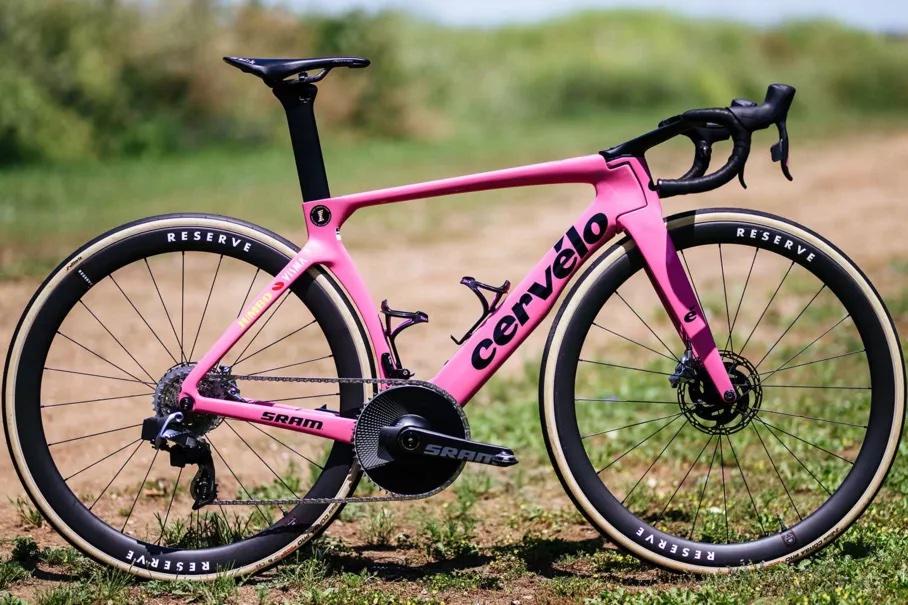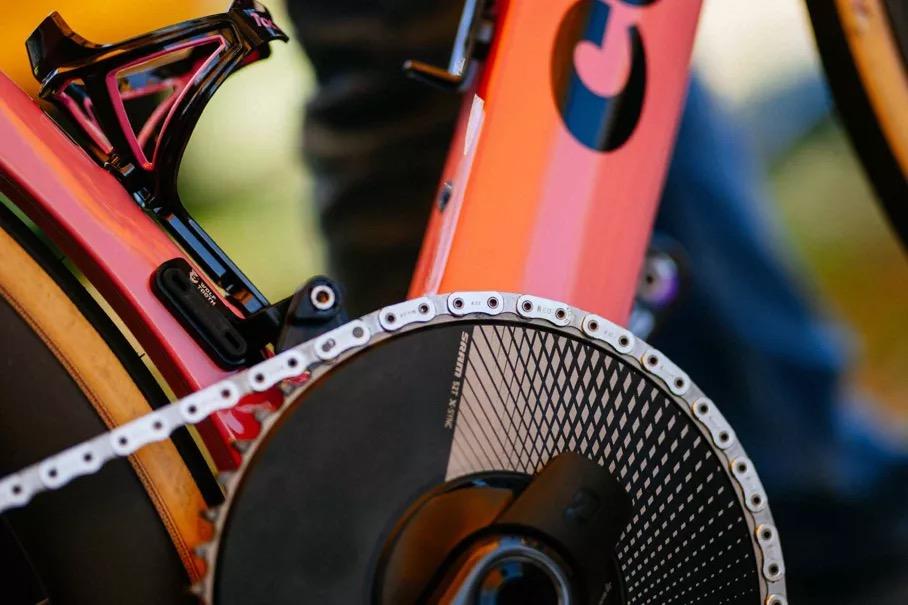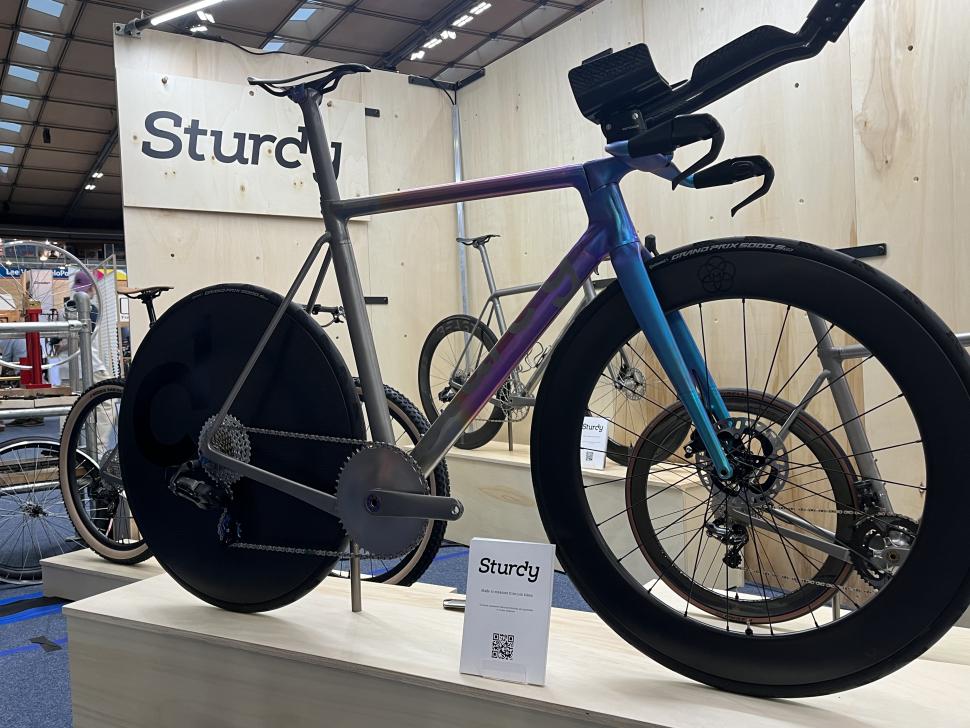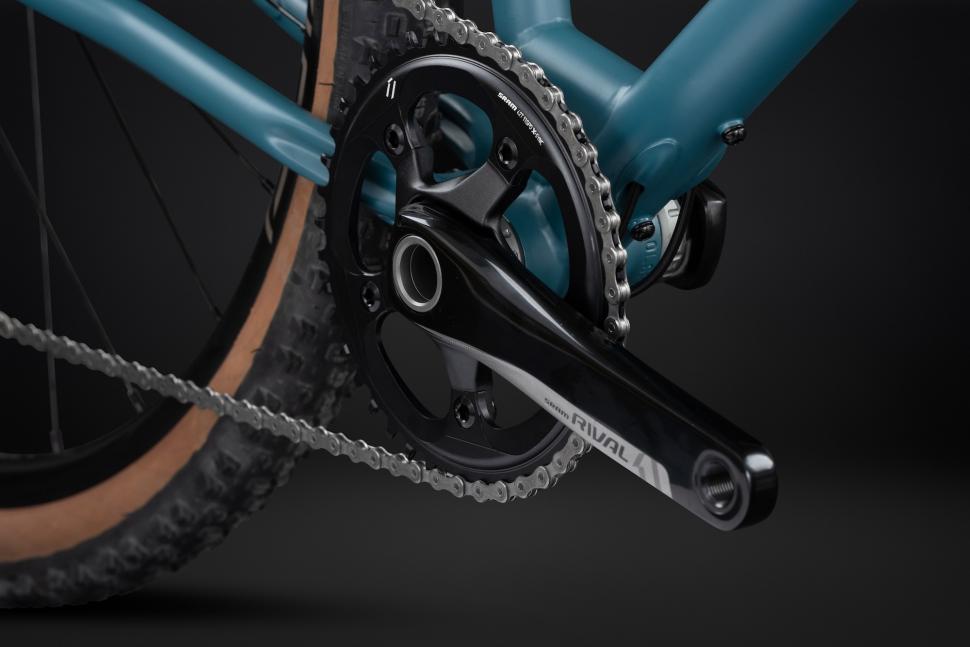- News
- Reviews
- Bikes
- Components
- Bar tape & grips
- Bottom brackets
- Brake & gear cables
- Brake & STI levers
- Brake pads & spares
- Brakes
- Cassettes & freewheels
- Chains
- Chainsets & chainrings
- Derailleurs - front
- Derailleurs - rear
- Forks
- Gear levers & shifters
- Groupsets
- Handlebars & extensions
- Headsets
- Hubs
- Inner tubes
- Pedals
- Quick releases & skewers
- Saddles
- Seatposts
- Stems
- Wheels
- Tyres
- Tubeless valves
- Accessories
- Accessories - misc
- Computer mounts
- Bags
- Bar ends
- Bike bags & cases
- Bottle cages
- Bottles
- Cameras
- Car racks
- Child seats
- Computers
- Glasses
- GPS units
- Helmets
- Lights - front
- Lights - rear
- Lights - sets
- Locks
- Mirrors
- Mudguards
- Racks
- Pumps & CO2 inflators
- Puncture kits
- Reflectives
- Smart watches
- Stands and racks
- Trailers
- Clothing
- Health, fitness and nutrition
- Tools and workshop
- Miscellaneous
- Buyers Guides
- Features
- Forum
- Recommends
- Podcast
feature
 Should you run a 1x set-up on a road bike? June 2023
Should you run a 1x set-up on a road bike? June 2023Should you run a 1x set-up on your road bike?
An increasing number of bikes now use 1x (pronounced one-by) drivetrains, which essentially means the bike has a single chainring with no front derailleur. It's a topic that divides opinion when it comes to using 1x on drop bar bikes, particularly dedicated road bikes. Is it the right choice for you?
A few years ago, a single chainring gear system for anything other than a mountain bike or cyclo-cross bike would have been unthinkable, but people are now embracing a 1x setup for commuting, gravel bikes, time trialling and increasingly, road bikes. Lets go through the pros and cons of running 1x and what cycling disciplines it's most suitable for...
It's generally a good idea for gear ratios to be fairly closely spaced, and the unquestioned way to get a wide range of gears on road bikes has been to have at least two chainrings. However, you can now have relatively closely-spaced gear ratios with just one chainring.
1x drivetrains use a single chainring, which saves the cost and complexity of a double chainring and eliminates the front derailleur and front shifter. This should give you one less thing to think about as you ride.
This isn't new technology. SRAM pioneered the use of 1x systems, initially for mountain bikes, then on cyclo-cross bikes, and now gravel bikes and road bikes. All versions of Force, Rival and Apex are available in 1x configurations (with a single chainring instead of a double).
The advantages of a 1x drivetrain
1x drivetrains are used across cycling disciplines, so the advantages vary depending on the terrain and specific riding style.
1. Simplicity and reduced weight
A 1x drivetrain eliminates the need for a front mech, front shifter and multiple chainrings, which simplifies the bike's set-up with one less component to fail. It also reduces the weight.
Gearing also becomes simpler, as you only need to think about shifting up and down the cassette, making it easier to operate.
2. Better chain retention
The teeth on 1x chainrings alternately engage with the links of the chain to reduce the chances of the chain coming off, even on rough terrain, which should provide a more secure and reliable set-up.
As well as better chain retention, the chances of dropping the chain are further reduced due to the lack of a front mech, eliminating the chances of it getting stuck or misaligned during shifting.
Without a front mech, a 1x system is also quieter due to the chain not rubbing on the front mech plates.
> Are the benefits of 1x outweighed by the disadvantages? We asked, you answered
3. Less maintenance
There's no front mech or front shifter, less chainrings and one less gear cable to look after, meaning there are fewer potential points of failure. There are therefore, fewer parts that can get damaged or require adjustment, resulting in less maintenance.
4. Improved clearance and frame design
With only one chainring and a lack of front mech, there is increased clearance around the bottom bracket area, which is beneficial particularly for off-road riding where debris can easily get caught in and around the drivetrain.
As a result of this improved clearance, frame geometry can be optimised depending on the cycling discipline, allowing for increased tyre clearance and greater frame stiffness.
5. Improved aerodynamics?
Many time triallists are opting for a 1x set-up for simplified shifting, but also the claimed aerodynamic benefits. A 1x drivetrain simplifies the front end of the bike by eliminating the front mech and multiple chainrings, and when combined with an aero frame, a good time trial position and aero wheels, is claimed to provide a minute aerodynamic advantage.
The disadvantages of a 1x drivetrain
As with the advantages of a 1x drivetrain, the disadvantages also depend on the cycling discipline, riding style, terrain and individual preferences.
1. Limited gear range
Modern 1x drivetrains offer a wide-range cassette, but the gearing range may not be as extensive as a 2x set-up. Whilst the easiest gear on a 1x set-up may get you up nearly anything, you may not progress up the hill as quickly, and then may find yourself running out of gears on long, fast descents.
When riding only on tarmac, up long and steep climbs, riders may find that a 1x system is limiting.
2. Big jumps between gears
As a result of the wide-ranging cassette, there can be some bigger jumps in gear ratios between each rear cog. It can therefore be difficult to keep your rhythm when changing from one gear to the next.
> All the gear? Check out the gearing choices of the pros at the Tour de France
3. Increased wear of components
Due to the 1x drivetrain only using a single chainring, it tends to wear out more quickly than a 2x drivetrain, where the wear can be distributed across the chainrings.
The chain and cassette may also wear more quickly due to an increased surface area of contact with a wider casette and large rear cogs.
4. Less efficient 'angled' chainline
The chaincould run at a more extreme angle for longer periods of time in a 1x set-up compared to 2x, where a straighter chainline can be achieved by dropping into the small ring when the chain is too high up the cassette. The 1x set-up may result in a less efficient power transfer and increased friction if riding at the upper or lower extremes of the cassette for extended periods.
5. Compatibility issues
It may be difficult to upgrade certain bikes to a 1x drivetrain as it doesn't fit on all bike frames, particularly older models.
You may need to upgrade other components on the bike as well, such as the shifters and rear hub, which adds to the overall cost.
> Check out the best gravel bikes 2023
So, what are 1x drivetrains suitable for?
It appears that 1x drivetrains offer a great general purpose set-up, but it comes down to what you use your bike for as to whether a 1x drivetrain is the best option for you.
Single-chainring systems are now almost universal on mountain bikes and cyclo-cross bikes, and used on many gravel bikes due to their simplicity, reduced chances of dropping the chain and improved clearance, with the wide gear range allowing riders to tackle climbs and descents.
A 1x system is also suitable for commuting and city riding when the terrain is relatively flat and predictable. It's simple to operate and there is a reduced need for maintenance, making it a convenient option.
Another cycling discipline 1x is suitable for is time trialling on relatively flat courses. The reduced chances of dropping the chain/having a mechanical and the simplicity of changing gears make it a practical choice.
Finally, 1x drivetrains are being seen more and more on road bikes in general, as well as on the pro's bikes at races. For example, Roglic chose a Cervélo R5 fitted with a single chainring up front and a dinnerplate cassette at the back for the 2023 Giro d’Italia mountain time trial, and we can expect to see more of this from other World Tour riders soon.
Overall, it is important to consider the terrain and the specific requirements of your riding style when deciding if a 1x drivetrain is best for you.
The bikes
Let's have a look at some of the best bikes we've reviewed with 1x drivetrains in recent years...
Road bikes
Vielo R+1 Alto Classified - £6,999
The Vielo R+1 Alto Classified is the British company's newest bike which was found to be a fast, fun and comfortable road bike that exploits the clean lines of a 1x with the gear ratios of a 2x.
Read our full review here.
This bike has radical looks but the Strada is a fast, comfortable and exciting aero race bike that works brilliantly.
Read our full review here.
Gravel bikes
Ribble Gravel 725 2023 - £2,099
Part of Ribble's new gravel-specific range, this bike has great geometry for all kinds of gravel riding and has that lovely steel 'zing'.
Read our full review here.
Orro Terra C Ekar 1x - £3599.99
This Orro Terra C Ekar has a 13-tooth cassette and is a great bike for those who want speed off the beaten track, and it'll happily carry your gear for longer adventures.
Read our full review here.
Canyon Grail AL 7 eTap - £2,249
For someone looking to get into gravel cycling and wanting a bike that will serve them for a long time, the Canyon Grail AL 7 eTap is an excellent option.
Read our full review here.
This is the brand's top of the range aluminium alloy gravel bike and one of the most comfortable and fun gravel bikes for the money.
Read our full review here.
Commuting bikes
This bike offers great comfort, quality braking, good gears and bags of all-round practicality – Giant shows there's life in the hybrid yet.
Read our full review here.
What are your thoughts on 1x drivetrains? Let us know in the comments section below.
Emily is our track and road racing specialist, having represented Great Britain at the World and European Track Championships. With a National Title up her sleeve, Emily has just completed her Master’s in Sports Psychology at Loughborough University where she raced for Elite Development Team, Loughborough Lightning.
Emily is our go-to for all things training and when not riding or racing bikes, you can find her online shopping or booking flights…the rest of the office is now considering painting their nails to see if that’s the secret to going fast…
Latest Comments
- slc 34 sec ago
Agreed, although women face additional barriers in busy places too. All the women cyclists I know report a much higher level of abusive behaviour...
- headingley 19 min 13 sec ago
Who actually cares if "bike to work" bikes aren't actually used for daily commuting ? (Apart from The Telegraph, of course) The fact that you can...
- Hirsute 27 min 48 sec ago
He does it to make a point. As I remember from his videos he is rarely not in control of the situation. Although as it's all on shitter these days,...
- Car Delenda Est 30 min 32 sec ago
Probably worth pointing out at some point that the Telegraph is on the Cycle to Work Scheme..
- mark1a 32 min 41 sec ago
It gets posted in road.cc comments around six times daily.
- mdavidford 33 min 46 sec ago
But if it's a bridleway or a permissive path they're within their rights to be.
- Secret_squirrel 1 hour 15 min ago
This is my favourite rant - but I really dont see the point of windproof cycling clobber that isn't properly waterproof - especially for the UK. ...
- leedorney 1 hour 24 min ago
Whenever I drive, which isn't much, I often wonder why other seem to just not care at all, it's like so sense and appreciation for any other human...
- chrisotherwise 1 hour 34 min ago
Thanks for all the kind replies. I was back on my bike yesterday and went and had a look at where I had my fall. No obvious diesel on the road or...
- Bob Sprocket 1 hour 42 min ago
Toe clips, now we're talking.














Add new comment
14 comments
Hi, I have set up by Specialized Crux to double as a racer and gravel bike using SRAM Eagle drive train with 12 speed 11-50T 44T chain ring. this works perfectly for x1 set up to do steep climbs on road wheels along with fast flat/downhill.
Some of the arguments will ride on how sensitive you are to finding your right cadence.
Some riders appear to be quite happy using their legs over a wide range of rpm, others have a narrow band.
If you are not a hardened cyclist, then fixies aren't practical. If you haven't got leg strength, then low cadence is asking for injuries, and if you haven't developed a high cadence then producing power can be a problem.
I would say that as an experienced cyclist, I would not inflict my personal preferences on others. I know what works for me, but without knowing the physique and motivation of another cyclist I'm not sure I could recommend a set up for someone else (though happy for them to listen to my views and take from them what they will).
I liked a triple, great for varied terrain, both on MTB and road bike, and I've never had major issues with chain drop once set up properly. 2x I now am happy with on a compact chainset with a 32 or 34 rear sprocket, but am constantly changing gears as the terrain or wind changes - on a 70 mile ride I want to be absolutely in my effective, efficient and comfortable range. I can't see myself being happy with the limitations of a 1x11. I'm sure I could get by, but why bother? If front derailleur hadn't been invented in sure I would be perfectly happy, but 2x and 3x exist, and I know how yo use them to suit me.
Hello Road.cc I would really really like to see a review of 1x systems from cheaper brands like Microshift or Sensah or any other I may not know.
Such a price seems reasonable to me https://www.aliexpress.com/item/1005003494996395.html?pdp_npi=3%40dis%21...
Swapping to 1x on my road bike because with a 53/39 chainring setup and 10-27 cassette I'm only ever using the top half of the cassette. Changing to a single 42 tooth front will cover pretty much all the gears I use and I won't be left in that do i / don't i shift on the front situation.
TBH i find cassette ranges are generally too big for a double set up these days anyway, 11-32? Do you really need that with a 52/34 chainring? Not for me.
I agree. Better for me is 13-34 as, like all the world champions who dominated the sport when I was growing up, I have no use for the 11T sprocket.
No, me neither. As a gentleman of a certain vintage I use a modified MTB cassette paired with a road triple. On my last 300km ride I used a 9-speed 13-34 cassette with a 50/39/30 triple from East Yorkshire to Middlesbrough and just got back before dark. I think I might have had to get off and push making my way over the North York Moors with the kit I was lugging as well as my 84kg self if I hadn't geared up to suit my ability and the terrain.
I can only imagine having a 1x system if in the future I have to give up and get an electric bike and such a setup is all that is available off-the-peg by then. Until that happens I shall stick with what works for me. It isn't 1x, which is needlessly expensive and limited, for claimed benefits that don't convince me in the slightest.
I agree about not needing the smaller sprockets but as that's all that's (easily) available in 11s the answer for me is a sub compact double chainset. Most of the time I'm in the "big" ring but having a granny available means I don't need a silly wide (expensive) cassette.
No.
Loved the look, concept and simplicity of 1x so built a road bike around it for London's flat geography. After a year or so I am going back to 2x mechanical.
The range of gears, better chainline and the ability to use a front mech to nudge the chain back on without getting off the bike if it ever does drop (not that it did with a narrow-wide chainring and a clutched rear mech) all completely outweigh the pros of 1x for road. Try it if you really need to scratch the itch, otherwise, don't bother.
Listing "chain retention" as a "pro" is surely a joke? Chain retention appears to be the achilles heal of (non-clutched-derailleur) road 1x setups.
And if you need to run a chain catcher on your 1x (as Jumbo-Visma and others do in cyclocross, where 1x has more use and longer experience of use), then surely "Aerodynamics" disappears from the "Pro" list too.
At which point, what on earth is the point of 1x (least, on road, where you don't want the drag of a clutched RD)?
It smells like the latest marketing fad to try sell us new bike frames and gear - which (yet again) is incompatible with most previous stuff.
The thing that puts me off a single front ring setup is I ride such a varied type of terrain. I could be on a very flat ride one day but the next ill decide to go up some hills. My bike has a 52/36 and a 11-28 ratios. I can get up most things on that and still have a decent range on the flat.
A pro racer knows exactly what they are riding that day, they know the gears they need to be in in most cases so can make that decision. Oh and they have a mech to do it all for them.
One thing mentioned as a 'pro' point for single 1x goupsets is better chain retention. Although when a professional team using it a few years back pointed the finger at its failure to stay on. https://road.cc/content/tech-news/243853-aqua-blue-boss-lab-rat-thing-costing-us-results-so-was-he-talking-about Im a little unsure thats actually true. And even though he still won in the end, Roglic dropped his chain in the Giro TT ffs. on a 1x setup. Ive dropped a chain before and actually got it back up by shifting the front derailleur , no chance of doing that if there isnt one to catch it.
If you do drop a chain, there are only 2 ways for it to go, if it falls inside you can put a chain catcher on so prevent it damaging YOUR bike, the one you paid good money for. Or it falls outside and wraps the chain around your crank arm scratching the crap out of it. Not an issue for a pro, its all team kit. They pull another one off the car and away you go, rest of us have a bike that looks like its been attacked with a chainsaw.
Well, back in my day... I've ridden 1x1, 1x3, 2x5, 2x6, 2x7, 3x7, 3x8, 3x9, 2x10, 2x11, 1x11 and 1x12.
On paper, 3x9 and 2x11 look like the best, because more gears = better. In the real world, having a 10rpm difference between a couple of gears is not something that matters. Just as I didn't go back to 3x once I had 2x10, there was no going back to 2x once I had 1x11. 1x12 wasn't a noticable improvement over 1x11, so you can save some money there...
The reasons for increased increased wear don't make any sense. I'd argue that the larger teeth on a 1x chainring would probably outlast both on a double. The increased wear on chain and cassette is due to the increased use of smaller sprockets not larger ones, particularly on undergeared mtbs and ebikes, something Shimano is addressing with the new Cues groupsets. The current situation of having to replace a huge expensive cassette because the smaller sprockets are worn is ridiculous.
Agree about the annoyance of replacing entire cassettes due to a few worn sprockets but it's been that way for a long time.
As mentioned in another topic I've been trying road 1x this year and enjoying it. The clutch derailleurs common in 1x systems ensure good chain retention and quiet running although I do wonder if they soak up a few watts.
I agree, excess wear is due to the smaller (overall) sprockets in play, but is also due to the amount of time the chain spends in less than ideal chain lines. This is less of an issue for MTB riding, as a lot of the time you just sit mid cassette, but on the road, if you are going hard / downhill, you will be at the sharp end of the cassette, and likewise going uphill, you will be towards the top of the cassette... you seem to spend little time mid-cassette and in a more optimal chain line.